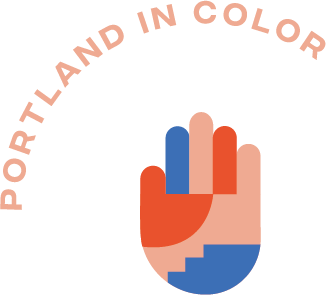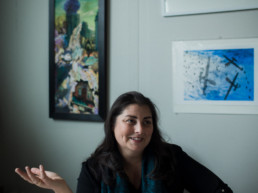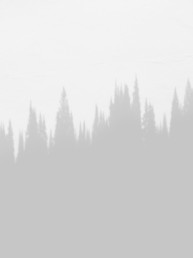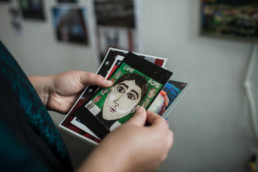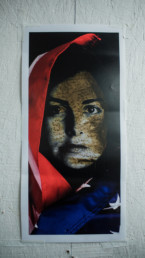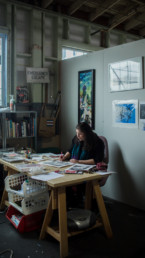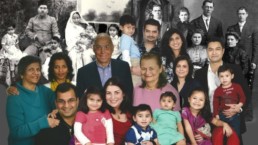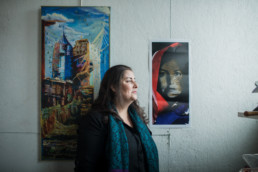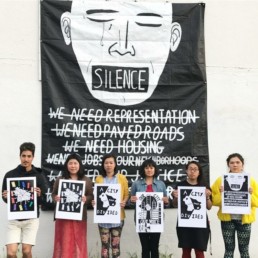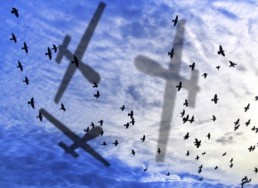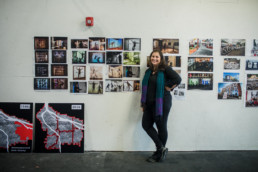SABINA ZEBA HAQUE
“I hope we continue to work through this and not just through the Trump years.”
Name: Sabina Zeba Haque
Pronouns: She/her and they/them
Medium of choice: Painting, drawing, performance, mixed media, film, community
Music on repeat: Nina Simone and Nusrat Fateh Ali Khan
Local artists you’re excited about: Subashini Ganesan, Wendy Red Star, Sarah Farahat, and Alex Chiu
Sabina Zeba Haque was born into a household of multiplicity. Her parents met on a bus near the University of Kansas where her Pakistani father was an architecture and engineering student. Her mother, a printmaker from Springfield, Ohio, designed cards for Hallmark, back when the work was still done manually. The couple permanently moved to Karachi, Pakistan in the 1970s to raise Sabina and her siblings.
Sabina’s work as an artist spans decades, mediums, borders, and themes—from the intersections of place and identity, to, more recently, the stories and experiences of community, near and far. Her family’s own stories of immigration, refuge, and international roots continue to shape her work, and her artist mother, who is also an educator and activist, remains a pivotal role model.
“It’s really important as artists to center voices of color and people who have not been given that opportunity within cultural institutions. If you want to do this right, bring community members, give them a stipend, [and] give them a voice. Art is always tied directly to community.”
What is your background?
I was raised in Karachi, Pakistan in the `80s by an American Christian woman who married my father, a Muslim who migrated from India to Karachi.
We celebrated Eid with my muslim relatives and celebrated Christmas with my mother. I lived in this very multicultural home, and was bilingual in Urdu & English. My parents and sisters still live in Pakistan.
When I was growing up in Karachi, the U.S. was funneling arms through Pakistan and funding Bin Laden, so I was living that history. At that time, the country was run by a military dictator—a very oppressive regime. I moved to the U.S. in 1992 for college. When 9/11 happened, America was still waking up. No one seemed to have any idea what had gone on in the previous two decades. I, on the other hand, grew up with a lot of knowledge around politics and the affected communities.
What is one project that you're particularly proud of?
The project and research I did with the Portland City Archives led me to work with the eastside Portland community and engage with them around issues of displacement and exclusion. I was an artist-in-residence exploring the changing identity of [Portland] over the last 35 years. Together with the community, we found really creative ways to communicate that [through] film, oral histories, theater, zines, and street performances. That was three years of work with multiple events.
Annexation & Assimilation, exploring the archive east of 82 Ave
A collage by Haque of her family. / Courtesy of Sabina Haque
What has your process been like in deciding which medium to use for a particular project?
The process and act of drawing is really important to me. I was trained as a painter/drawer, though I now see myself as a multi-media artist. For the longest time, I was working in the 2D realm, then with the onslaught of Apple, I was able to digitize anything and everything.
I used to act out some of my early work, like my self portrait photo series, “Muslim American Woman.” My process was really about the idea of how we use our body to express issues around identity. The performance was a very important part of the process that was not made visible to the viewer, but now is visible and deliberately part of my art practice. In the last couple of years, storytelling has become really important too. How do we communicate not just those key images, but what happens in between?
My artwork explores the two places I call home: the U.S. and Pakistan. Sometimes they are in conflict with one another. In Hood River, we have one of the largest drone manufacturers [in Oregon]. The drones that are made in my backyard are flying over the backyards of people in Pakistan and killing civilians—3,000 civilians. In 2013, a [Pakistani] grandmother was killed while gardening in her backyard. Her grandson [testified] to U.S. congress and said, “I no longer love blue skies. I prefer gray skies. The drones don’t fly when the skies are gray.” I had to tell that story.
I made this stop-motion animated film about drone warfare [in 2015 with] videographer Ian Lucero. “Remembrance” documents the process of creation and destruction, and also [commemorates] the people who have been lost.
That blew open my process. I started to integrate my community-based practice, which I was doing with teaching, into my art-making.
With the oral history project, “Under the Same Blue Sky,” I went to [IRCO] Africa House and worked with Somali women there for a few months, developing trust. Six women shared their refugee and immigration stories. I made these hanging translucent screens, covered in their handwritten stories, [and] paired [them] with their recorded story. We had a panel at the Portland Art Museum where Somali woman activist, Lul Abdulle, and Djimet Dogo, director of Africa House, spoke. [The event] drew a large African immigrant audience, many of whom were first-time museum visitors.
It’s really important as artists to center voices of color and people who have not been given that opportunity within cultural institutions. If you want to do this right, bring community members, give them a stipend, [and] give them a voice. Art is always tied directly to community.
For more on Sabina Haque’s art, check out their extensive body of work online which includes information on their past residencies, zines, “War Games,” and more.
A piece by Haque inspired the testimony of a Pakistani grandson, who lost his grandmother in 2013 and said, “”I no longer love blue skies. I prefer gray skies. The drones don’t fly when the skies are gray.” / Courtesy of Sabina Haque
